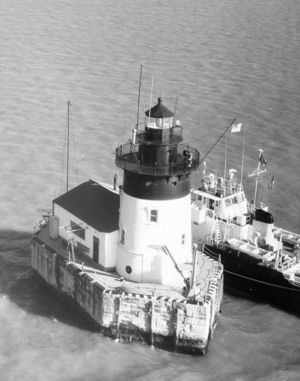Detroit River Light facts for kids
 |
|
| Undated USCG photo | |
|
|
|
| Location | Lake Erie south of Detroit River, Monroe County, near Berlin Charter Township |
|---|---|
| Coordinates | 42°0′2.7″N 83°8′26.45″W / 42.000750°N 83.1406806°W |
| Year first constructed | 1875 (lightship) 1885 (current tower) |
| Automated | 1979 |
| Foundation | Wood/cement crib Granite pier |
| Construction | Cast iron with brick lining |
| Tower shape | frustum of a cone with attached building. |
| Markings / pattern | White with black top |
| Height | 49 feet (15 m) |
| Focal height | 55 feet (17 m) |
| Original lens | 4th order Fresnel lens |
| Range | 10 nautical miles (19 km; 12 mi) |
| Characteristic | Fl(2) W 6s |
| Fog signal | Horn: 1 every 30s |
| Racon | "X" (X-ray) |
| ARLHS number | USA-227 |
| USCG number | 6885 |
The Detroit River Light is a cool lighthouse in Lake Erie. It's also called the Bar Point Shoal Light. This lighthouse helps guide ships safely into the Detroit River. It was first a special boat called a lightship in 1875. The lighthouse you see today, which looks like a "sparkplug" because of its shape, was built in 1885.
It sits about 1.75 nautical miles (about 3.2 kilometers) from land. It's also quite close to the border with Canada. The original special lens, called a 4th order Fresnel lens, is now at the Michigan Maritime Museum.
Contents
Building the Lighthouse
The Detroit River Light took the place of a Canadian lightship. That lightship had been helping boats in this spot since 1875. It guided ships that were turning into the Detroit River.
The United States Lighthouse Board finished building the Detroit River Light in 1885. It cost about $78,000, which was a lot of money back then! The light first shone on August 20, 1885.
The base of the lighthouse, called a crib, was built somewhere else. It was then brought to the spot from Amherstburg, Ontario. This crib was 45 feet by 18 feet (about 13.7 by 5.5 meters). Workers sank it into 22 feet (about 6.7 meters) of water. They filled it with concrete and surrounded it with a granite pier.
The pier around the lighthouse base is shaped like the front of a boat. This special shape helps it break up ice floes that float down the river. Above this strong base, the lighthouse tower stands 49 feet (about 15 meters) tall. It's made of cast iron with a brick lining. The tower is 22 feet (about 6.7 meters) wide at the bottom and 18 feet (about 5.5 meters) wide at the top. There's also a building attached for storage and a radio beacon.
Building Challenges
Building the lighthouse was not easy! There were some big problems. When the crib base was first put down, it wasn't level. It was about 16 inches (about 40 centimeters) off! Winter was coming, so workers loaded 550 tons of stone onto the pier. They put most of the stone on the higher side. When they came back in the spring, the weight of the stone and the moving ice had made the granite pier perfectly level.
How the Lighthouse Worked
The Detroit River Light was built to have people living and working in it. These people were called Coast Guardsmen. They sometimes called the lighthouse "The Rock" because it felt so isolated, like a lonely island. Today, the light works all by itself, thanks to automation.
The Lighthouse Today
In December 1997, a large freighter named the M/V Buffalo crashed right into the lighthouse! The ship was sailing down to Lake Erie. Luckily, the lighthouse's rock and stone base only had a little damage. But the freighter's steel front was pushed in like a "tin can," with a 25-foot (about 7.6-meter) gash.
The special lens inside the lighthouse has been changed a few times. Each time, it changed the unique signal the light sent out to ships. The lens used now has six sections. Three of these sections have bright "bull's-eye" panels, and the other three are blind panels.
The lighthouse also has a fog signal. This is like the one at Harbor Beach Light. The Detroit River Light is still an active guide for boats today. You can't visit it, but you can see it from a boat. A good place to start a boat trip to see it is from the south end of Grosse Ile, Michigan.
The Detroit River Light Station was added to the National Register of Historic Places on August 4, 1983. This means it's a very important historical site!
The lighthouse has even been honored in sculptures.
Lighthouse Keepers
These are some of the people who worked as keepers at the Detroit River Light:
- Charles Northup (1885–1886 and 1893–1898)
- Richard Oddrey (1887–1890)
- Joseph Crawford (1898–1902)
- Enoch Scribner (1902–1912)
- Horace Watts (1912–1916)
- Walter Marshall (1916–1919)
- Harry K Condway (1919–1921)
- John Sweet (1926–1933)
- William Small (1933–1938)
- Eli Martin (1938–1939)


